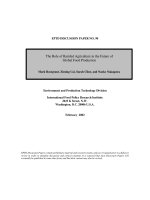Phytoremediation - The Wave of the Future
Bạn đang xem bản rút gọn của tài liệu. Xem và tải ngay bản đầy đủ của tài liệu tại đây (771.8 KB, 17 trang )
Chapter 7
Phytoremediation: The Wave of the Future
Jerry S. Succuro, Steven S. McDonald, and Casey R. Lu
Abstract As the industrial age developed, societies have allowed large amounts
of contaminants to enter the environment unchecked. As a result of this neglect,
the incidence of heavy-metal contaminated sites has been on the rise. These sites
are polluted with toxic hydrocarbons and radionuclides, as well as heavy met-
als, such as cadmium (Cd), chromium (Cr), copper (Cu), lead (Pb), and zinc
(Zn). The result is unsightly areas left untreated, undeveloped and are accurately
referred to as “Brown Fields.” Heavy metals in the soil can create a contaminated
and possibly toxic top layer ranging 2–5 cm deep in addition to the possibility
of entering the food chain. The typical and most common method of removing
contaminants is to excavate the soil by mechanical means and store it at off-site
locations.
Phytoremediation is an innovative, emerging technology that utilizes plant species
to remove contaminants from the environment using a distinct set of plant-based
technologies. Four types of remediation technologies have been employed: (1) phy-
tostabilization is the use of a plant’s root system to stabilize the metal-contaminated
soil thus preventing the spread of the contaminant; (2) phytodegradation is the pro-
cess of using plants to convert toxic contaminants into less toxic forms; (3) rhi-
zofiltration is the process of using plants to clean aquatic environments; and finally,
(4) phytoextraction is the practice of using plants to take up metals from the soil
and translocate them to the above-ground tissues which can then be harvested. By
utilizing phytoremediation techniques, the environmental disruption is minimized,
soil fertility is maintained, secondary air- and water-borne wastes are reduced, and
these techniques are well received by the public as in situ methods. This chapter will
discuss the use of multiple plant species in each of the listed remediation techniques
for the goal of rejuvenating Earth’s ecosystems.
J.S. Succuro (
B
)
Department of Biological Sciences, Humboldt State University, Arcata, CA 95521, USA
e-mail:
119
A. Kirakosyan, P.B. Kaufman, Recent Advances in Plant Biotechnology,
DOI 10.1007/978-1-4419-0194-1_7,
C
Springer Science+Business Media, LLC 2009
120 J.S. Succuro et al.
7.1 Introduction
During the industrial age, humans have allowed large amounts of contaminants to
enter the environment unchecked. As a result of this neglect, many toxins have been
permitted to accumulate in our soils and water systems. Since this neglect was
allowed to continue for so long, the incidence of heavy-metal contaminated sites
has been on the rise. The public is made aware of this issue through the media. In
most cases, the media have a tendency to paint a very grim picture of how these
contaminated sites will affect humans and animals alike (Environmental Protection
Agency, 2007). For the most part, their interpretation of the situation is correct. Con-
taminated sites do exist and are polluted with toxic hydrocarbons and radionuclides,
as well as heavy metals, such as cadmium (Cd), chromium (Cr), copper (Cu), lead
(Pb), and zinc (Zn) (Amaya-Chavez et al., 2006). This heavy-metal contamination
is a result of anthropogenic activities such as metal mining and smelting, agricul-
ture, sewage sludge, fossil fuel combustion, and chemical manufacturing (Alloway,
1995). In addition to manufacturing types of activities, recreational sports such
as the use of shooting ranges and improper storage techniques add to the list of
sources (Alloway, 1995; Ebbs and Kochian, 1997). Often these sites of contamina-
tion become unsightly reminders of the lackadaisical attitude people take toward the
environment.
These large, unsightly areas are often left untreated, undeveloped and are accu-
rately referred to as “Brown Fields.” Brown fields, or any other smaller toxic sites,
are subject to wind-blown dispersion if the soil is disturbed and the heavy metal
is set free. As the wind blows across the disturbed soil, soil particles and associ-
ated contaminants can be blown into the upper atmosphere and travel rather large
distances, thus contaminating locations, such as playgrounds, parks, and yards thou-
sands of miles from the original site (Xei et al., 1999). In addition to wind dispersal,
when a heavy metal such as lead contacts the soil, it becomes tightly adsorbed to the
soil particles. This can create a contaminated and possibly toxic top layer of soil that
ranges 2–5 cm deep (Sharma and Dubey, 2005), where, in playgrounds or backyards,
it becomes a threat to human health. Another concern for heavy-metal contaminated
sites is the possibility of it entering the food chain. Although animals, plants, and
microbes have no biological need for certain specific heavy metals, they can be
taken up and sequestered in the cells of living organisms. Furthermore, these heavy
metals can be moved from plants to animals as they graze on contaminated sites.
Once the heavy metal enters the food chain, secondary and tertiary predators can be
adversely affected by the quantities of metal present (Taylor and Crowder, 1983a).
As these organisms in the higher trophic levels continue to consume heavy-metal
contaminated foods, the toxic level within these organisms also increases (Taylor
and Crowder, 1983a,b). This process is known as bioaccumulation.
In response to public outcry, the US Environmental Protection Agency (EPA)
has spent billions of dollars on Superfund site cleanup projects across the nation
(Bouchier and Lu, 2002; USEPA, 1993). As public awareness increases, so have
the questions concerning how safe areas such as playgrounds, homes, and gardens,
are for plants and animals (including humans). The largest concern regarding the
7 Phytoremediation: The Wave of the Future 121
toxicity or accumulation of heavy metals, such as lead, is directed toward small
children. Their bodies and central nervous systems are developing rapidly and
any exposure to lead, even blood levels as low as 10 μgdL
−1
, can cause long-
term health problems within many organ systems. Examples of affected systems
include, but are not limited to, gastrointestinal tract, cardiovascular system, ner-
vous system, kidneys, immune, reproductive, and mental and physical impairment
(www.epa.gov/iaq/lead.html, 2007; ATSDR, 2007; Pyatt and Gratten, 2001). Poten-
tial areas of concern for children are the ingestion of soil particles in playgrounds,
and most importantly, the consumption of small lead-based paint chips in homes
built before 1960, and the inhalation of lead dust from painted friction surfaces.
In an attempt to reduce exposure to heavy-metal contamination in soils, several
methods of disposal have been developed. The typical and most common method
is to excavate the soil by mechanical means using tractors and bulldozers, and then
to transport the soil to another location where it is stored (Memon et al., 2001;
Cunningham et al., 1995). Even though these storage facilities are lined with mate-
rial to prevent the spread of contamination, the sites themselves become areas that
are uninhabitable. In some cases, these sites become problems as heavy metals
escape the confines of the protective barriers such as native claystone soils (ATSDR,
2005) and leach into the surrounding area and possibly nearby sources of ground-
water. In addition to excavation of contaminated sites, some sites are remediated
by the process of covering the soil with large quantities of concrete, asphalt, and/or
clean, uncontaminated soil (Berti and Cunningham, 2000), which temporarily fixes
the problem right where it lays by covering it to reduce contact. When these types
of remediation techniques are used, they only satisfy an immediate and temporary
fix to a long-term problem. In addition, these options can be very costly. Depend-
ing on the type of management strategy, remediation of a site by traditional means
can cost between $10 and $3,000 m
−3
per year (Cunningham et al., 1995). No one
really knows what the long-term ramifications will be if these types of manage-
ment techniques are allowed to continue. In light of this problem, a developing new
technology has begun to focus on utilizing plants to decontaminate areas of high
concentrations of heavy metals and organic contamination. This new technology is
termed phytoremediation.
7.2 What Is Phytoremediation?
Phytoremediation is an innovative, emerging technology that utilizes plant species
to remove contaminants from the environment (Tian et al., 2007; Amaya-Chavez
et al., 2006). Much research has been conducted in this field and is gaining global
acceptance because of the possibility of adapting this technology to many different
types of ecosystems in both developed and developing countries. The term phy-
toremediation stems from the words “phyto,” meaning plant, and the Latin suffix
“remedium,” meaning to clean or restore. Phytoremediation refers to a distinct set
of plant-based technologies utilizing naturally occurring and/or genetically mod-
ified plants to remove contaminants, such as metals and hydrocarbons from soil,
122 J.S. Succuro et al.
sediments, or water systems (Padmavathiamma and Li, 2007; Amaya-Chavez et al.,
2006). Plants accomplish this task by removal, transfer, stabilization, or decom-
position of these contaminants in the environments listed above (Hughes et al.,
1997). Heavy metals contaminate the major environmental systems of our planet:
air, water, and soil; therefore, biogeochemical cycles can be severely disrupted (Tian
et al., 2007). Heavy-metal pollution in soil differs from that of air- and water-based
systems because heavy metals have a tendency to remain in the soil for very long
periods of time. There are two major categories of contaminants that should be
considered, elemental pollutants and organic pollutants, each of which has its own
set of remediation strategies (Meagher, 2000). These will be discussed later in this
chapter. Based on the type of contaminant, site conditions, quantity of contami-
nant to be removed, and the species of plants to be used for the process, four types
of remediation technologies have been employed. They are classified based on the
containment of metals (phytostabilization and phytodegradation) or the extraction
of metals (phytofiltration and phytoextraction) (Padmavathiamma and Li, 2007). A
brief description of these processes is as follows: (1) phytostabilization is the use
of a plant’s root system to stabilize the metal-contaminated soil thus preventing the
spread of the contaminant; (2) phytodegradation is the process of using plants to
convert toxic contaminants into less toxic forms; (3) rhizofiltration is the process
of using plants to clean aquatic environments; and finally, (4) phytoextraction is the
practice of using plants to take up metals from the soil and translocate them to the
above-ground tissues which can then be harvested. In order for a plant to be listed
as a good candidate for phytoremediation, several factors should be met. A plant
must be tolerant to the environmental conditions of the contaminated site as well as
be fast-growing and produce high quantities of biomass in harvestable tissue (Yang
et al., 2005). With these conditions met, the phytoremediation process can begin.
7.2.1 Why Is Phytoremediation Important?
Taking into account the above-listed remediation techniques, the first thoughts
that come to mind are cost and how environmentally sound the phytoremediation
practices are at removing the contaminant from the environment. Traditionally,
contaminated sites are remediated by physical, chemical, or biological processes
(McEldowney et al., 1993). In the aftermath of the destructive treatments, irre-
versible effects may occur to soil properties. The destruction of biodiversity can
render soils useless for the growth of plants that could potentially remove remaining
contamination (Padmavathiamma and Li, 2007). By utilizing phytoremediation
techniques, the environmental disruption is minimized, soil fertility is maintained,
secondary air- and water-borne wastes are reduced, and these techniques are well
received by the public as in situ methods (Tian et al., 2007; Amaya-Chavez
et al., 2006; Padmavathiamma and Li, 2007). In some cases, phytoremediation
may be the only solution for reducing contaminated soil and water systems that
cover hundreds of thousands of square kilometers as a result of human activity
(Meagher, 2000). The harvesting of plants that have accumulated large quantities
7 Phytoremediation: The Wave of the Future 123
of usable metals in their tissues, such as nickel, zinc, and copper, could be recy-
cled and used for other purposes, thus producing an economic incentive for using
phytoremediation (Ow, 1996). In addition to being environmentally friendly, the
phytoremediation process may also be cost-effective (Padmavathiamma and Li,
2007; Zhuang et al., 2007a,b; Yang et al., 2005). In the recent past, the cost to handle
contaminated waste was approximately $100 m
−3
for incineration, $60–$300 m
−3
for landfill, $200–$700 m
−3
for special landfill requirements, and $1,000–$3,000
m
−3
to dispose of radionuclides per year (Cunningham et al., 1995). Using the
techniques of phytoremediation, these costs are reduced remarkably to levels of
only $5–$40 t
−1
and $0.02–$1.00 m
−3
per year (Padmavathiamma and Li, 2007;
Cunningham et al., 1995).
7.2.2 Remediation of Organic Contaminants
Over many decades, humans have added large volumes of contaminants to the soil,
water, and atmosphere as a result of industrial manufacturing such as petroleum
and chemical operations and private independent operations such as dry-cleaning.
In addition to these processes, burning wood, coal, and fossil fuels, add a wide range
of organic chemicals to the environment, potentially causing negative health effects
for humans as well as wildlife. Further anthropogenic causes include car emissions,
waste incineration, service stations, solvent use, cigarette smoking, and the use of
pesticides.
Organic contaminants are carbon-containing compounds that are resistant to
environmental degradation through chemical, biological, and photolytic processes.
These compounds can be transported great distances, bioaccumulate in both human
and other animal tissues, as well as biomagnify in food chains. Health agencies have
identified several compounds as being extremely toxic to humans, wildlife, and the
environment. This list is by no means complete, but it includes aldrin, chlordane,
DDT, dieldrin, endrin, heptachlor, PCBs, and toxaphene (Fig. 7.1).
Some chemical properties of these organic toxins include decreased water solu-
bility, increased lipid solubility, semi-volatility, and higher molecular weights. With
their higher molecular weights and the addition of chlorine (Cl) substituents, the
compounds are increasingly difficult to break down and remain persistent in the
environment. Finally, their lipid solubility results in the ability of these molecules to
pass through biological phospholipid membranes and bioaccumulate in fatty tissues.
Humans may experience contamination through exposure from diet, environment,
and accidental discharges into the atmosphere or spills into the soil. Deleterious
health effects include damage to the endocrine system, the reproductive system,
the immune system, neurological disorders, cancer, and ultimately, death. In con-
trast, compounds with lower molecular weights, less than 236 g mol
−1
, are usually
less toxic, thus reducing the health issues and environmental problems as a result
of being less persistent ( />2007).
124 J.S. Succuro et al.
Chlordane DDT
Aldrin
HeptachlorEndrinDieldrin
Methyl parathion (MeP)
Fig. 7.1 Chemical structures of organic contaminates that are environmental risks to humans and
wildlife
Current research suggests that there are two different ways by which organic
contaminants can be removed from soil- and water-based systems, namely, phy-
todegradation and rhizofiltration. First we look at phytodegradation (Fig. 7.2), the
process that utilizes plants and their associated microflora to convert hydrocarbons
to non-toxic forms (Cunningham et al., 1995).
The conversion of contaminants by plants takes place in the following manner:
First the plant releases root exudates that include organic and inorganic substances
into the rhizosphere (soil–root–microorganism interface zone) during metabolism.
These root exudates act as substrates for soil microorganisms, thus enhancing the
uptake and degradation of toxic organic compounds by the plants. This principle
has been used to remediate crude oil, motor oil, and diesel fuel from soils (Chaineau









